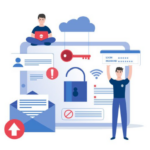Publishers play a crucial role in promoting digital inclusivity and accessibility. As more content is being consumed digitally, it becomes increasingly important to ensure that everyone, regardless of their abilities or disabilities, can access and engage with the content in a meaningful way. Publishers have the power to make a significant impact in this area by implementing inclusive practices throughout the publishing process. Here are some key ways in which publishers can promote digital inclusivity and accessibility.
Creating accessible content formats
Publishers can make their digital content accessible by providing alternative formats such as audio descriptions, closed captions, transcripts for videos, and text-to-speech capabilities for written content. By offering multiple formats, publishers ensure that individuals with visual impairments, hearing impairments, or cognitive disabilities can access and understand the content.
Implementing inclusive design principles
Publishers should adopt inclusive design principles from the early stages of content creation. This involves considering the diverse needs and preferences of users during the design process, such as using clear and simple language, providing adjustable font sizes and colors, and logically structuring content. The inclusive design ensures that content is accessible to a wide range of individuals, including those with disabilities or limited technological literacy.
Prioritizing web accessibility
Publishers should adhere to web accessibility guidelines, such as the Web Content Accessibility Guidelines (WCAG), to ensure their websites and digital platforms are accessible to all users. This includes optimizing website navigation, providing alternative text for images, ensuring keyboard accessibility, and making sure that content can be accessed through assistive technologies like screen readers.
Partnering with assistive technology developers
Publishers can collaborate with developers of assistive technologies to ensure compatibility and optimize the user experience for individuals with disabilities. By working together, publishers and assistive technology developers can identify and address barriers that may exist in accessing digital content.
Educating content creators
Publishers should educate their content creators, including authors, editors, and designers, about the importance of digital inclusivity and accessibility. Training programs can help content creators understand the needs of diverse audiences and provide them with the tools and knowledge to create accessible content from the outset.
Engaging with advocacy groups
Publishers can collaborate with advocacy groups focused on digital inclusivity and accessibility to gain insights, share best practices, and receive feedback on their efforts. These partnerships can help publishers stay up to date with emerging trends and technologies and ensure that their practices align with the needs of the diverse communities they serve.
Embracing inclusive marketing strategies
Publishers should adopt inclusive marketing strategies to reach a broader audience and communicate their commitment to accessibility. This includes showcasing diverse representation in promotional materials, highlighting accessibility features, and engaging with communities that advocate for digital inclusivity.
Role of Publishers in Promoting Digital Inclusivity
Publishers play a crucial role in promoting digital inclusivity by ensuring that their content is accessible to a wide range of users, regardless of their abilities or disabilities. Here are some key aspects of the role of publishers in promoting digital inclusivity:
Content Creation
Publishers can prioritize inclusivity from the early stages of content creation. This involves considering the needs of diverse audiences and creating content that is accessible to individuals with disabilities. Publishers should strive to use clear and simple language, provide descriptive alt text for images, and structure content in a logical manner. They can also incorporate multimedia elements, such as audio descriptions and closed captions, to make the content accessible to people with visual or hearing impairments.
Digital Platforms
Publishers are responsible for the design and development of digital platforms where their content is hosted. They should ensure that these platforms adhere to web accessibility guidelines, such as the Web Content Accessibility Guidelines (WCAG). This includes optimizing website navigation, implementing keyboard accessibility, and providing alternative text for non-text content. Publishers should also ensure that their platforms are compatible with assistive technologies like screen readers, allowing individuals with disabilities to access the content effectively.
Alternative Formats
Publishers can make their content more inclusive by providing alternative formats. For instance, offering audio versions of written content benefits individuals with visual impairments or those who prefer auditory learning. Publishers can also provide text-to-speech capabilities for individuals who may have difficulty reading or comprehending written text. By offering multiple formats, publishers accommodate a wider range of user preferences and accessibility needs.
Collaboration with Experts
Publishers can collaborate with accessibility experts and consultants to ensure that their content and platforms meet accessibility standards. These experts can provide guidance on inclusive design principles, accessibility testing, and assistive technology compatibility. By working with experts, publishers can continuously improve their practices and stay up to date with evolving accessibility standards.
Education and Training
Publishers have a responsibility to educate their content creators about digital inclusivity and accessibility. By providing training programs and resources, publishers can empower their teams to create content that meets accessibility guidelines. This includes training authors, editors, and designers on best practices for creating accessible content and providing guidelines for incorporating accessibility features.
User Feedback and Iterative Improvement
Publishers should actively seek feedback from users, particularly those with disabilities, to identify any barriers or challenges they may encounter when accessing digital content. User feedback can help publishers identify areas for improvement and make necessary adjustments to enhance accessibility. This iterative process ensures that publishers continuously strive to provide a more inclusive digital experience.
Advocacy and Awareness
Publishers can advocate for digital inclusivity and raise awareness about accessibility issues. They can actively engage in discussions and initiatives related to digital accessibility, participate in conferences and events, and collaborate with advocacy groups. By actively promoting the importance of digital inclusivity, publishers contribute to creating a more inclusive digital landscape.
How can publishers create accessible content formats?
Publishers can create accessible content formats by providing alternative formats such as audio descriptions, closed captions, and transcripts for videos. They can also implement text-to-speech capabilities for written content. These measures ensure that individuals with visual impairments, hearing impairments, or cognitive disabilities can access and understand the content.
Publishers can create accessible content formats by following best practices and incorporating features that make their content accessible to individuals with disabilities. Here are some key steps to create accessible content formats.
Alternative Text for Images
Publishers should provide alternative text (alt text) for images used in their content. Alt text is a brief description of the image that can be read by screen readers or other assistive technologies. This allows individuals with visual impairments to understand the content and context of the images.
Captions and Transcripts for Videos
Publishers should include captions or subtitles for videos to make them accessible to individuals with hearing impairments. Captions provide text representation of the audio content, allowing users to read along. Additionally, providing transcripts alongside videos can benefit individuals who prefer reading or need to access the content in a text-based format.
Structured Content
Publishers should logically structure their content, using proper headings, lists, and formatting. This helps individuals using screen readers or other assistive technologies to navigate and understand the content more easily. Using semantic markup, such as HTML headings (h1, h2, h3, etc.), ensures proper content hierarchy and accessibility.
Clear and Simple Language
Publishers should use clear and simple language in their content to enhance comprehension for a wide range of users. Avoiding jargon, complex sentence structures and excessive use of technical terms helps individuals with cognitive disabilities or limited literacy to access and understand the content more effectively.
Descriptive Links
Publishers should use descriptive links instead of generic terms like “click here” or “read more.” Descriptive links provide users with context and information about the linked content, enabling individuals using screen readers to understand the purpose of the link without relying solely on visual cues.
Accessible Document Formats
Publishers should consider the accessibility of documents, such as PDFs, Word documents, or e-books. Using accessible document formats or ensuring that existing documents are made accessible is essential. This may involve adding tags to PDFs, structuring the content properly, and ensuring compatibility with assistive technologies.
How can publishers educate content creators about digital inclusivity and accessibility?
Publishers can educate content creators by providing training programs and resources on digital inclusivity and accessibility. These programs help content creators understand the needs of diverse audiences and provide them with the tools and knowledge to create accessible content. Training can cover topics such as inclusive design principles, accessibility guidelines, and incorporating accessibility features into content creation.
Publishers can take several steps to educate content creators about digital inclusivity and accessibility. Here are some effective strategies:
Training Programs
Publishers can develop training programs specifically designed to educate content creators about digital inclusivity and accessibility. These programs can cover topics such as inclusive design principles, accessibility guidelines (e.g., WCAG), and best practices for creating accessible content. Training sessions can be conducted in person, through webinars, or by utilizing online learning platforms.
Accessibility Guidelines and Resources
Publishers should provide comprehensive accessibility guidelines and resources to content creators. These guidelines can outline specific steps and techniques for creating accessible content, including guidance on structuring content, adding alt text for images, captioning videos, and making documents accessible. Publishers should also provide accessibility checklists and templates to help content creators follow best practices.
Workshops or Seminars
Publishers can organize workshops or seminars led by accessibility experts. These sessions can include demonstrations, hands-on exercises, and interactive discussions to deepen content creators’ understanding of accessibility principles and practices. Workshops can cover topics such as accessible document formatting, multimedia accessibility, and creating accessible web content.
Collaboration and Feedback
Publishers should foster a collaborative environment where content creators can seek guidance and feedback on their work. This can involve regular meetings or check-ins with accessibility experts or dedicated accessibility teams within the publishing organization. Content creators can receive feedback on their content’s accessibility and learn from real-world examples and case studies.
Accessible Templates and Tools
Publishers can provide content creators with accessible templates and tools to streamline the creation of accessible content. This can include pre-designed templates for documents, slide presentations, and web pages that incorporate accessibility features. Content creators should also have access to assistive technology tools and resources to test the accessibility of their content.
Ongoing Communication and Updates
Publishers should establish a channel of communication with content creators to provide updates on evolving accessibility standards, guidelines, and practices. This can be done through regular newsletters, internal forums, or dedicated communication platforms. Publishers should encourage content creators to share their experiences, challenges, and success stories related to accessibility.
Potential Impact of publishers promoting digital inclusivity and accessibility
The overall impact of publishers promoting digital inclusivity and accessibility is significant and far-reaching. Here are some key impacts:
Increased Access
By prioritizing digital inclusivity and accessibility, publishers ensure that their content is accessible to a wider range of individuals, including those with disabilities. This increased access allows individuals with visual impairments, hearing impairments, cognitive disabilities, or other limitations to engage with the content on an equal footing, enabling them to access information, entertainment, educational resources, and more.
Empowerment and Independence
Accessible content empowers individuals with disabilities, giving them the independence to navigate and consume digital content without significant barriers. By removing obstacles and providing alternative formats, publishers enable individuals to access content in ways that suit their unique needs and preferences, fostering a sense of autonomy and inclusivity.
Equal Opportunities
Promoting digital inclusivity and accessibility ensures that individuals with disabilities have equal opportunities to participate in various aspects of life, such as education, employment, and social engagement. Accessible content allows for equal access to educational materials, job applications, online services, and social platforms, reducing the disadvantages faced by individuals with disabilities.
Positive Social Impact
By actively promoting digital inclusivity, publishers contribute to a more inclusive and accepting society. Inclusive content helps break down barriers and stigmas associated with disabilities, fostering greater empathy, understanding, and respect for diversity. It promotes the idea that everyone deserves equal access to information and opportunities, creating a more inclusive digital culture.
Conclusion
Publishers play a vital role in promoting digital inclusivity and accessibility in the age of technology. By prioritizing accessibility throughout the publishing process, publishers can ensure that their content is accessible to individuals with disabilities and create a more inclusive digital environment.
The impact of publishers promoting digital inclusivity and accessibility is far-reaching. It leads to increased access and empowerment for individuals with disabilities. By actively embracing their role, publishers contribute to creating a more equitable, diverse, and inclusive digital landscape for all.
codemantra’s Solutions for Publishers & University Press
Increasing creation & demand for content, along with a growing need for more formats across channels & devices, requires unprecedented operational agility. codemantra delivers these solutions for publishers who need a single window, cross-functional publishing requirements that reduce time to market & improve ROI. We provide the following services:
- Document Transformation – Transform assets/documents into digital assets for downstream use and consumption into various formats like XML, ePUB, MOBI, HTML5, and other digital formats.
- Accessibility Compliance – Make documents accessible as required by Section 508, PSBAR, EAA, or other international laws to serve people with print disability better and conform to WCAG AA standard.
- Contract Processing – Transform documents, extract data, convert into actionable insights, push the data into any existing application for singular data ingestion, and speed up business processes.
codemantra’s intelligent document processing solution enables digitization of the entire document processing workflow, thereby optimizing systems and boosting business growth. We have remediated close to 4 million pages for 8+ Fortune 500 Publishers as our Clients! Connect with us: engage@codemantra.com









